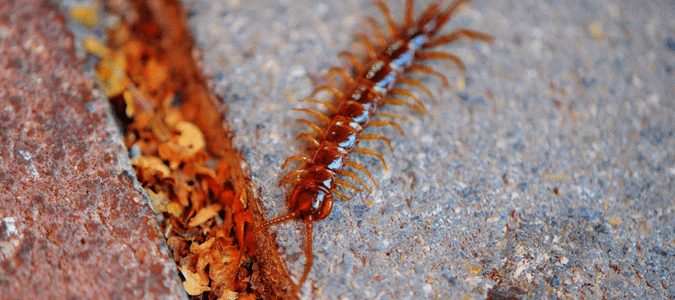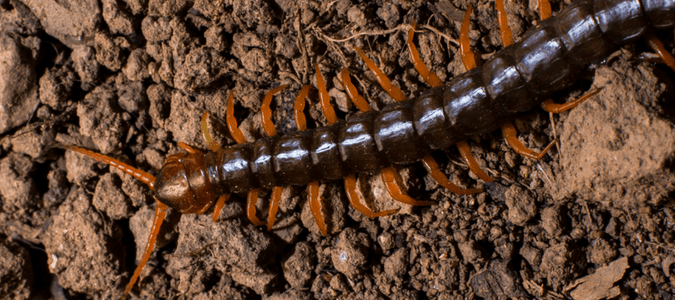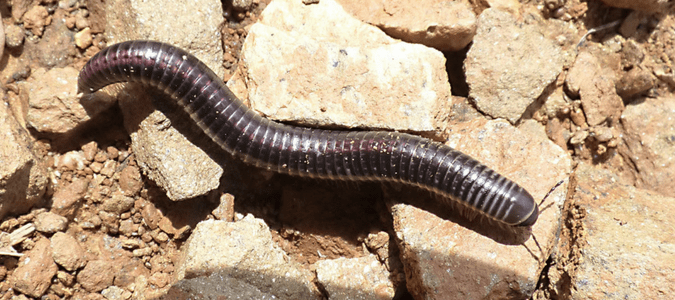
Does the very thought of centipedes and millipedes make you shudder? If so, you definitely aren’t alone. Fear of centipedes even has its own name: chilopodophobia (centipedes are arthropods belonging to the Chilopoda class, which gives this particular phobia its name).
Even if you’re a nature-lover to your core, there’s just something a little skin-crawly about all those many, many feet attached to that long, smooth, armor-like body. It’s hard not to recoil instinctively when you discover one of these critters under a rock or while digging in the dirt, but are centipedes in Texas really as creepy as many believe? What should you do if you come across one in your yard or, worse, inside your home? Let’s find out by learning more about these insects, along with Texas millipedes and other similar creatures.
What Risks Do Centipedes Pose?
The word “centipede” literally means “one hundred feet,” as it derives from the Latin words for “one hundred” (centum) and “foot” (ped). Most centipedes in Texas and elsewhere don’t actually have one hundred legs, however—just as millipedes don’t actually have anywhere close to one thousand legs. Similar to “centipede,” “millipede” comes from the Latin words for “one thousand” and “foot.” Centipedes have segmented bodies that usually have one pair of legs per segment; thus, the number of legs they have depends on the number of segments that make up their bodies, which depends on their particular species. Some species of centipede have fewer than thirty legs total, while certain other species have closer to 400.
Texas is home to several different types of centipedes, including some that are quite famous for their size as well as their sting. Beyond their innate creepiness, though, what risks do they actually pose to humans? If you encounter a centipede—especially one of the larger, more threatening types—what should you do to protect yourself and your home?

Giant Redheaded Centipede
One of the most frightening-looking varieties of centipede in Texas is the giant redheaded centipede, which is famous first and foremost for its size. True to the mythology of this great state—most residents are familiar with the saying, “Everything’s bigger in Texas!”—giant redheaded centipedes can grow to eight to nine inches long and a half-inch wide (and that’s not even counting their leg span!).
These critters’ coloring is intimidating as well: True to their name, giant redheaded centipedes have bright-red heads sporting long, spiky, reddish-yellow antennae, and 21 pairs of long, yellow, claw-like legs that are attached to the segments of their long, shiny, black bodies. The black, red and yellow color combination seems to send a signal to some deeply instinctive part of the human brain, transmitting a message of danger. In fact, the same is true for other animals and insects that encounter the giant redheaded centipede; nature designed this creature’s coloration specifically to warn potential predators away. But are these centipedes really as terrifying as they appear?
Giant redheaded centipedes eat many different types of insects, including spiders, cockroaches, moths and butterflies. While insects make up the majority of their diet, they have also been known to eat lizards, toads, small snakes and other small animals. After hunting and locating their prey, these centipedes immobilize the prey by gripping their victim with those claw-like legs and using a pair of legs that act as fangs to inject the prey with a painful, burning toxin.
Unfortunately, giant redheaded centipedes have been known to bite humans when accidentally or deliberately provoked, and their bites are reported to sting painfully. Are centipedes poisonous? Fortunately, however, the poison from a giant redheaded centipede bite is nowhere near strong enough to kill a human. While no one wants to suffer from a massive centipede bite, for most people, the most trouble it will cause is short-term swelling and discomfort at the site of the bite. Some people may also have an allergic response to the bite and suffer from more generalized symptoms such as nausea, dizziness and headaches. These, too, though, will soon subside on their own.

Giant Desert Centipede: A Different Creature?
If you’ve ever heard of the giant desert centipede, you might wonder what’s the difference between this scarily large critter and the similarly named giant redheaded centipede. The answer is, they are one and the same: “Giant desert centipede” is just one of several common names by which the giant redheaded centipede is known. Other common names include Texas redheaded centipede and giant Sonoran centipede.
Whichever name it’s known by, the giant desert centipede (or giant redheaded centipede) can be found in Texas as well as in nearby states including Arizona, New Mexico, Kansas, Arkansas, Oklahoma and Louisiana. In Texas, this type of centipede is most common in Garner State Park, located in the Hill Country region west of San Antonio, and in Palo Duro Canyon, in the northern panhandle portion of the state. According to Texas Parks and Wildlife, however, giant redheaded centipede sightings are not uncommon in many portions of the state, and encounters between these centipedes and humans are relatively commonplace.
For this reason, it’s important to know what to do if you happen to cross paths with one of these critters. The natural environment of a giant redheaded centipede is the dark, protected spaces underneath rocks or rotting logs. Just like any other insect or animal, these critters need water, so they prefer to live in a moist area; this is why they are more likely to head indoors during the hot, dry months of summer.
Thus, if you see a giant redheaded centipede on your porch or inside your home, remember that they probably aren’t out to terrorize you and your family; they are most likely simply in search of water. The same is true for those found in your garden: They were probably drawn to the moisture of a well-watered area that can provide them the damp conditions they need to survive.
Still, the question remains: If you see one, what should you do? Run away screaming? Find a boot and give it a good whack? Or take a more tolerant—yet appropriately cautious—approach?

Texas Millipede Vs. Texas Centipede: Similarities And Differences
Before we explore what to do when you encounter a centipede—especially a large and frightening one—in your indoor or outdoor living space, let’s learn a little more about Texas millipedes.
Like centipedes, millipedes are arthropods with pairs of jointed legs attached to the many segments of their long bodies. Whereas centipedes have only one pair of legs per body segment, however, millipedes can have multiple pairs per segment, and they also typically have a higher number of segments overall. Since their legs are naturally closer together on their bodies, they have the appearance of having far more legs than centipedes, even if they don’t in reality. Despite their higher numbers of legs, though, millipedes tend not to move as quickly as centipedes do.
While centipedes dine on other insects, arthropods and even small animals, millipedes typically feed on decaying organic matter, such as dead leaves, roots and bark. For this reason, millipedes make their homes in the same types of places and conditions as centipedes: in the dark, moist areas of your yard and garden, where they have access to plenty of water as well as dead organic matter.

What Attracts Centipedes And Millipedes, And How To Keep Them Away
If you are the unlucky recipient of a bite from a centipede, it’s important first and foremost not to panic. It is very likely that the only symptoms you’ll have will be the pain or stinging sensation of the bite itself, and possibly some short-term swelling or tenderness at the site of the bite. An allergic reaction is possible, however, so it is a good idea to seek medical care from your doctor in the event of a bite, especially if the bite produces more severe symptoms or if it came from a giant redheaded centipede.
Even if you’re never bitten by a centipede, it’s still smart to know what attracts centipedes and millipedes, and how to keep them away from your home and yard. Since these critters are attracted to dark, damp places such as beneath rocks, mulch or rotten logs, it is important to clear tree branches away as soon as they fall on your property and keep rock piles and firewood well away from your home and outdoor living areas. You might also consider using rock or gravel beds around the perimeter of your home instead of mulch, since rocks and gravel drain moisture away better than mulch, making them a less attractive habitat for centipedes, millipedes and other creatures.
If you have ongoing problems with finding centipedes and millipedes indoors, dehumidifying the air inside your home should help. It can also help to plug weep holes in the outside of your home and properly seal all windows and doors to the outside, to prevent all types of insects from coming in.
ABC Helps Texans With Pest Problems
Giant redheaded centipedes can live for several years, and adult female redheaded centipedes can lay between 15 and 60 eggs per year. American house centipedes can lay even more eggs, often between 60 and 150 per year. Still, it is rare to find a “nest” or infestation of any type of centipede. It is far more common to spot just one or two centipedes out in the open in your home, yard or garden. Even so, spotting just one centipede can be a shocking experience, especially if you encounter a large one—and it is also a sign that there may be other centipedes living nearby.
If you do find a centipede in your home, in order to avoid the unpleasant surprise of further encounters—along with the possibility of a painful bite—Texas homeowners can call on ABC to help. Our pest control specialists are experienced with every step of the process to get rid of all types of home and lawn pests: identification, creating and implementing a customized treatment plan and ultimately preventing these and many other unwelcome creatures from coming into your home in the future. With the help of our skilled technicians, you won’t be at risk of any more centipede sightings, or bites, in the future.
